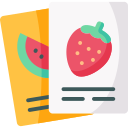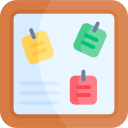✨ What It Does:
This feature allows therapists and parents to create multiple copies of the same flashcard within a session, enabling
flexible and personalized exercises tailored to the child’s learning needs.
Instead of being limited to a single instance of a flashcard, users can duplicate cards as needed to support structured
activities like sorting, sequencing, and matching exercises.
🔹 Key Benefits:
✅ Instant Flashcard Duplication – No need for printing; easily create multiple copies within seconds.✅ Enhanced Exercise Design – Supports structured activities like ordering, categorizing, and matching concepts.✅ Flexible & Adaptive Learning – Allows therapists and parents to adjust exercises in real time to match the child's pace.✅ Encourages Creative Learning – Helps design engaging, interactive, and personalized activities that keep children motivated.
🔹 Real-Life Applications
🟢 Sorting Activities – Use duplicate flashcards to group objects by color, size, or category.🟢 Sequencing Exercises – Arrange flashcards to teach step-by-step processes (e.g., "brushing teeth" in correct order).🟢 Matching Games – Reinforce memory and recognition by pairing identical flashcards together.
📌 Why This Feature is a Game-Changer ?
🟢 Traditional flashcards limit flexibility and require manual effort to duplicate, making it difficult to adapt sessions dynamically.
🟢 This feature removes those restrictions, allowing on-the-fly customization, real-time learning adjustments,
and endless creative possibilities for therapy and education.
📌 More flexibility, more engagement, and more effective learning—all with just a few taps.
🔹 Practical Applications of the Flashcard Duplication Feature
1️⃣ Body Parts & Senses
💡Matching Exercise: Duplicate the "eye" flashcard multiple times and ask the child to find all the "eyes" in a full-body diagram.
💡Sorting Activity: Duplicate flashcards for "eye," "ear," and "nose" and have the child arrange them based on their functions (seeing, hearing, smelling).
2️⃣ Family Members
🧲 Classification Game: Duplicate flashcards for "father," "mother," and "brother" and have the child group them based on characteristics or roles.
🧲Question Game: Present flashcards for "father" and "mother" and ask the child, "Who cooks the food?" or "Who drives the car?"
3️⃣ Animals
📎Animal Sorting: Duplicate flashcards for "lion," "dog," and "chicken" and ask the child to categorize them into wild, domestic, or farm animals.
📎 Sound Matching: Provide flashcards of animals along with recorded sounds and ask the child to match them correctly.
4️⃣ Food & Drinks
👀 Healthy Eating Game: Duplicate flashcards for "apple," "cucumber," and "candy" and ask the child to separate healthy from unhealthy foods.
👀Color Matching: Use fruit and vegetable flashcards to help the child match items with their correct colors (e.g., "red apple" with "red color" flashcard).
5️⃣ Shapes & Colors
💎 Shape Matching: Duplicate "circle," "square," and "triangle" flashcards and ask the child to place each in its correct category.
💎Color Game: Duplicate different color flashcards and ask the child to collect all cards of the same color.
6️⃣ Transportation
🔹 Classification Activity: Duplicate "car," "bicycle," and "airplane" flashcards and ask the child to sort them into land, sea, or air transportation.
🔹Size Ordering: Duplicate various transport flashcards and ask the child to arrange them from smallest to largest.
7️⃣ Emotions & Expressions
🟢 Emotion Matching: Duplicate flashcards for "happy," "sad," and "angry" faces and have the child match them with appropriate situations or phrases.
🟢 Emotion Sequencing: Ask the child to arrange emotion flashcards from most positive to most negative.
8️⃣ Clothing & Personal Items
🟢 Seasonal Sorting: Duplicate clothing flashcards like "shirt," "shoe," and "hat" and ask the child to sort them by season (e.g., summer vs. winter wear).
9️⃣ Professions & Tools
🟢 Tool Matching: Duplicate "doctor" and "carpenter" flashcards and ask the child to match
each profession with the correct tool (e.g., "stethoscope" for doctor, "hammer" for carpenter).
🟢 Task Sequencing: Arrange flashcards showing different tools in the order they would be used for a specific job.
🔟 Kitchen & Household Appliances
🟢 Tool Classification: Duplicate flashcards for "spoon," "oven," and "refrigerator" and have the child sort them into manual tools vs. electrical appliances.
🟢 Function Matching: Ask the child to match appliances with their functions (e.g., "microwave" with "heating food").
1️⃣1️⃣ Months, Seasons & Days
🟢 Arranging Months – Duplicate flashcards of months and ask the child to arrange them in calendar order.
🟢 Matching Seasons – Match season flashcards with appropriate clothing (e.g., "Winter" with "Coat").
1️⃣2️⃣ Plants
🟢 Plant Parts Ordering – Duplicate flashcards for "Leaf," "Stem," and "Root" and ask the child to place them in order.
🟢 Plant Classification – Categorize plants into "Flowering," "Leafy," and "Fruiting."
1️⃣3️⃣ Games & Sports
🟢 Equipment Matching – Match sports equipment flashcards with the correct sport (e.g., "Ball" with "Football").
🟢 Sport Classification – Sort sports flashcards into "Individual" and "Team" sports.
1️⃣4️⃣ Places & Countries
🟢 Flag Matching – Match flag flashcards with the correct country name.
🟢 Place Categorization – Duplicate flashcards for "School," "Park," and "Market" and categorize them as "Recreational" or "Educational" places.
1️⃣5️⃣ Home Furniture & Natural Phenomena
🟢 Furniture Arrangement – Duplicate flashcards for "Bed," "Desk," and "Chair" and have the child place them correctly in a virtual room.
🟢Natural Phenomena Matching – Match "Rain," "Sun," and "Snow" flashcards with their respective weather images.
1️⃣6️⃣ Letters & Numbers
🟢 Letter Matching – Match letter flashcards with words that start with the same letter.
🟢 Number Ordering – Duplicate number flashcards and have the child arrange them in ascending or descending order.1️⃣7️⃣ Sentence Formation & Grammar
🟢 Sentence Formation – Duplicate multiple word flashcards and have the child arrange them into a correct sentence.
🟢 Error Correction – Provide flashcards with incorrect sentences and ask the child to correct them using the appropriate flashcards.
1️⃣8️⃣ Verbs & Actions
🟢 Verb Matching – Duplicate flashcards for verbs like "Sit," "Run," and "Jump" and match them with corresponding pictures.
1️⃣9️⃣ Opposites & Directions
🟢 Opposite Words Game – Duplicate flashcards for words like "Big" and "Small" and have the child match them with their opposites.
🟢Direction Matching – Place "Right" and "Left" flashcards in a sequence based on given instructions.
 Speech Therapy Sessions Assistant App
Speech Therapy Sessions Assistant App



